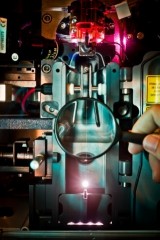 At many supermarkets, you can dump a pocketful of change into a machine that rapidly counts your coins, sorting them into pennies, nickels, dimes, and quarters and computing the total amount.
At many supermarkets, you can dump a pocketful of change into a machine that rapidly counts your coins, sorting them into pennies, nickels, dimes, and quarters and computing the total amount.
Imagine something similar in a research lab. In the past, cells had to be manually studied and counted under a microscope. But the development of flow cytometry technology, beginning in the 1960s and continually improving, has brought automation to counting and sorting human cells that’s reminiscent of the coin machine.
Flow cytometry today is routinely used in medical diagnosis of certain cancers, like lymphomas and leukemias, and as a powerful research tool for studying a host of different cell types and their interactions with drugs or the immune system.
“Investigators may be trying to look at a certain kind of cancer cell or immune system cell,” said Wayne Green, PhD, director of Dana-Farber’s Flow Cytometry Core Facility. “The analyzers can count the members of a certain subpopulation of cells, and then cull them so they can be grown in laboratory culture or used in gene expression studies.”
With the newest equipment, as many as 20,000 cells per second can be measured as they stream in single file through a narrow, fluid-filled chamber. Each cell passes through a laser beam whose light is scattered when it strikes the cell; the scattering pattern yields information about the cell’s type, size, and internal components. The laser beam also excites fluorescent molecules attached to the cells, which give off bursts of light in several colors.
Electronic detectors that ring the stream of cells capture both the scattered and fluorescent light. When analyzed by computer software, the information provides a readout of the number of cells and the physical properties correlated with each. These may be of interest to scientists studying cancer biology, cell development and function, or the immune system.
Some instruments mainly analyze the cells, while others use an additional electric field to steer specific cells into individual vials, each containing a pure sample of the desired cell type.
If a sample of cells were a crowd of people, Green explains, “Flow cytometry could tell you the physical attributes of each individual, such as hair color, gender, height, or weight. Then you could ask questions like, ‘In a group of 1,000 people, how many are women with brown hair who are five feet tall or shorter?’”
The expertise and precision instruments of the Flow Cytometry Core reflect how, in the pursuit of improved understanding and better treatments, today’s scientists are harnessing the power of technology of all kinds to strip away the secrets of cancer.
